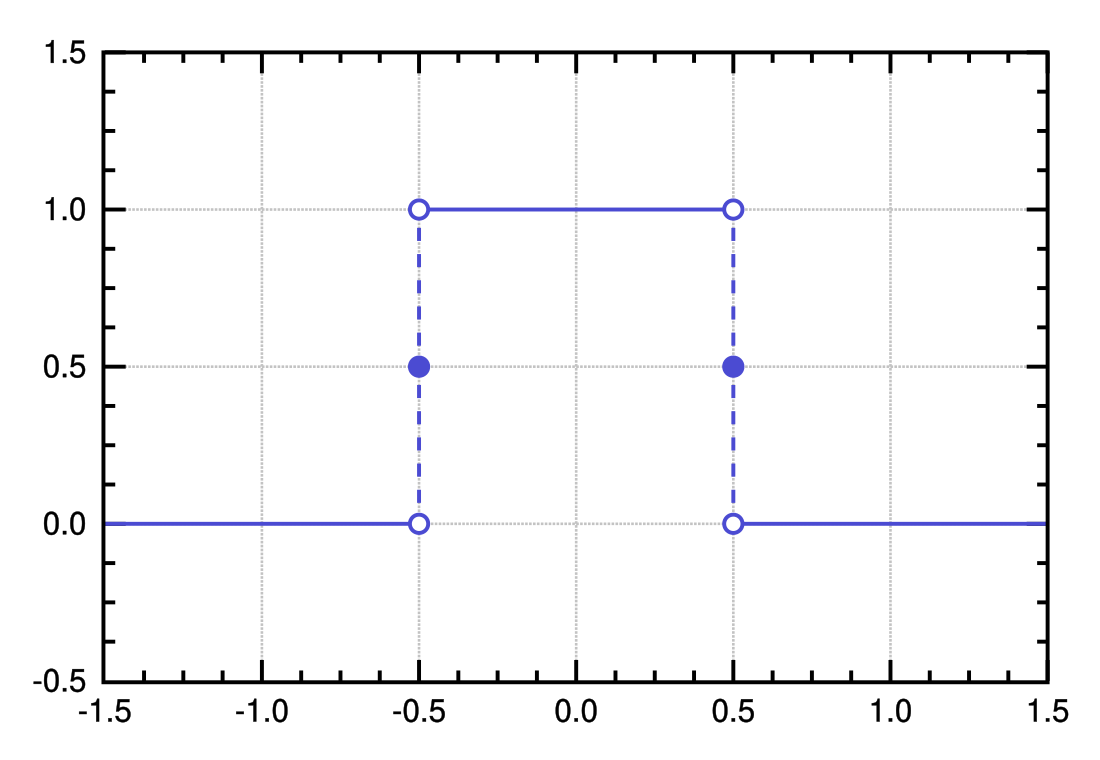Top Qs
Timeline
Chat
Perspective
Rectangular function
Function whose graph is 0, then 1, then 0 again, in an almost-everywhere continuous way From Wikipedia, the free encyclopedia
Remove ads
The rectangular function (also known as the rectangle function, rect function, Pi function, Heaviside Pi function,[1] gate function, unit pulse, or the normalized boxcar function) is defined as[2]

Alternative definitions of the function define to be 0,[3] 1,[4][5] or undefined. The area under the curve does not change for the different definitions of the functions at .
The rectangular function can be used as the basis for a rectangular wave.
Remove ads
History
The rect function has been introduced 1953 by Woodward[6] in "Probability and Information Theory, with Applications to Radar"[7] as an ideal cutout operator, together with the sinc function[8][9] as an ideal interpolation operator, and their counter operations which are sampling (comb operator) and replicating (rep operator), respectively.
Relation to the boxcar function
Summarize
Perspective
The rectangular function is a special case of the more general boxcar function:
where is the Heaviside step function; the function is centered at and has duration , from to
Remove ads
Fourier transform of the rectangular function

The unitary Fourier transforms of the rectangular function are[2] using ordinary frequency f, where is the normalized form[10] of the sinc function and using angular frequency , where is the unnormalized form of the sinc function.
For , its Fourier transform is
Remove ads
Self convolution of the Rectangular function
Summarize
Perspective

The self convolution of the dis-continuous rectangular function results in the triangular function, a piecewise defined spline that is continuous, but not continuously differentiable. Successive convolutions of the rectangular function result in piecewise defined pulses with lower maximums which are wider and smoother, with "smoother" meaning higher-order derivatives are coninuous.[11]
A convolution of the discontinuous rectangular function with itself results in the triangular function, which is a continuous function:
Self convolution of the rectangular function applied twice yields a continuous and differentiably continuous parabolic spline:
A self convolution of the rectangular function applied three times yields a continuous, and a second order differentiably continuous cubic spline:
A self convolution of the rectangular function applied four times yields a continuous, and a third order differentiably continuous 4th order spline:
Since the Fourier Transform of the Rectangular function is the Sinc function, the Convolution theorem mean that the Fourier transform of pulses resulting from successive convolution of the Rectangular function with itself is simply the Sinc function to the order of the number of times that the convolution function was applied + 1 (i.e., the Fourier transform of the Triangular function is Sinc2, the Fourier transform of parabolic spline resulting from two successive convolutions of the Rectangular function with itself is Sinc3, etc.)
Remove ads
Use in probability
Summarize
Perspective
Viewing the rectangular function as a probability density function, it is a special case of the continuous uniform distribution with The characteristic function is
and its moment-generating function is
where is the hyperbolic sine function.
Remove ads
Rational approximation
Summarize
Perspective
The pulse function may also be expressed as a limit of a rational function:
Demonstration of validity
First, we consider the case where Notice that the term is always positive for integer However, and hence approaches zero for large
It follows that:
Second, we consider the case where Notice that the term is always positive for integer However, and hence grows very large for large
It follows that:
Third, we consider the case where We may simply substitute in our equation:
We see that it satisfies the definition of the pulse function. Therefore,
Remove ads
Dirac delta function
The rectangle function can be used to represent the Dirac delta function .[12] Specifically,For a function , its average over the width around 0 in the function domain is calculated as,
To obtain , the following limit is applied,
and this can be written in terms of the Dirac delta function as, The Fourier transform of the Dirac delta function is
where the sinc function here is the normalized sinc function. Because the first zero of the sinc function is at and goes to infinity, the Fourier transform of is
means that the frequency spectrum of the Dirac delta function is infinitely broad. As a pulse is shorten in time, it is larger in spectrum.
Remove ads
See also
References
Wikiwand - on
Seamless Wikipedia browsing. On steroids.
Remove ads



















































